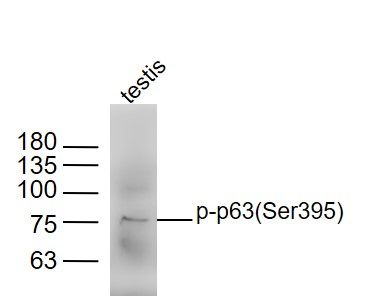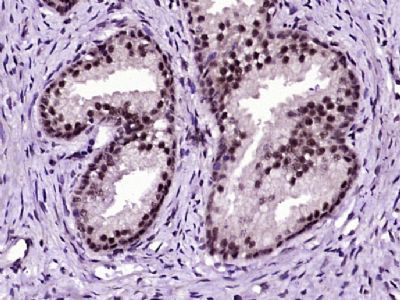产品中心
当前位置:首页>产品中心Anti-Phospho-p63 (Ser395)
货号: bs-3714R 基本售价: 1580.0 元 规格: 100ul
产品信息
- 产品编号
- bs-3714R
- 英文名称
- Phospho-p63 (Ser395)
- 中文名称
- 磷酸化P63肿瘤抑制基因抗体
- 别 名
- p63 (phospho S395); p63 (phospho Ser395); p-p63 (Ser395); AIS; Amplified in squamous cell carcinoma; B(p51A); B(p51B); p63 Alpha; Chronic ulcerative stomatitis protein; CUSP; DN p63 alpha 1; DNp63; EEC3; Keratinocyte transcription factor; Keratinocyte transcription factor KET; KET; LMS; NBP; OFC8; p40; p51; P51/P63; p53 like transcription factor; p53 related protein; p53-related protein p63; p53CP; p63; P73; p73H; p73L; RHS; SHFM4; TP53CP; TP53L; TP63; TP73; TP73L; Transformation related protein 63; Trp53rp1; Trp63; Tumor protein 63; tumor protein 63 kDa with strong homology to p53; Tumor protein p53-competing protein; Tumor protein p53-like; tumor protein p63; Tumor protein p73; tumor protein p73-like; P63_HUMAN.
- 规格价格
- 100ul/1580元购买 大包装/询价
- 说 明 书
- 100ul
- 产品类型
- 磷酸化抗体
- 研究领域
- 肿瘤 免疫学 信号转导 细胞凋亡 转录调节因子 激酶和磷酸酶
- 抗体来源
- Rabbit
- 克隆类型
- Polyclonal
- 交叉反应
- Human, Mouse, Rat, Chicken, Dog, Pig, Horse, Sheep,
- 产品应用
- WB=1:500-2000 ELISA=1:500-1000 IHC-P=1:400-800 IHC-F=1:400-800 IF=1:100-500 (石蜡切片需做抗原修复)
not yet tested in other applications.
optimal dilutions/concentrations should be determined by the end user.
- 分 子 量
- 77kDa
- 细胞定位
- 细胞核 细胞浆
- 性 状
- Lyophilized or Liquid
- 浓 度
- 1mg/ml
- 免 疫 原
- KLH conjugated Synthesised phosphopeptide derived from human p63 around the phosphorylation site of Ser395:RR(p-S)PD
- 亚 型
- IgG
- 纯化方法
- affinity purified by Protein A
- 储 存 液
- 0.01M TBS(pH7.4) with 1% BSA, 0.03% Proclin300 and 50% Glycerol.
- 保存条件
- Store at -20 °C for one year. Avoid repeated freeze/thaw cycles. The lyophilized antibody is stable at room temperature for at least one month and for greater than a year when kept at -20°C. When reconstituted in sterile pH 7.4 0.01M PBS or diluent of antibody the antibody is stable for at least two weeks at 2-4 °C.
- PubMed
- PubMed
- 产品介绍
- background:
This gene encodes a member of the p53 family of transcription factors. An animal model, p63 -/- mice, has been useful in defining the role this protein plays in the development and maintenance of stratified epithelial tissues. p63 -/- mice have several developmental defects which include the lack of limbs and other tissues, such as teeth and mammary glands, which develop as a result of interactions between mesenchyme and epithelium. Mutations in this gene are associated with ectodermal dysplasia, and cleft lip/palate syndrome 3 (EEC3); split-hand/foot malformation 4 (SHFM4); ankyloblepharon-ectodermal defects-cleft lip/palate; ADULT syndrome (acro-dermato-ungual-lacrimal-tooth); limb-mammary syndrome; Rap-Hodgkin syndrome (RHS); and orofacial cleft 8. Both alternative splicing and the use of alternative promoters results in multiple transcript variants encoding different proteins. Many transcripts encoding different proteins have been reported but the biological validity and the full-length nature of these variants have not been determined. [provided by RefSeq, Jul 2008].
Function:
Acts as a sequence specific DNA binding transcriptional activator or repressor. The isoforms contain a varying set of transactivation and auto-regulating transactivation inhibiting domains thus showing an isoform specific activity. May be required in conjunction with TP73/p73 for initiation of p53/TP53 dependent apoptosis in response to genotoxic insults and the presence of activated oncogenes. Involved in Notch signaling by probably inducing JAG1 and JAG2. Plays a role in the regulation of epithelial morphogenesis. The ratio of DeltaN-type and TA*-type isoforms may govern the maintenance of epithelial stem cell compartments and regulate the initiation of epithelial stratification from the undifferentiated embryonal ectoderm. Required for limb formation from the apical ectodermal ridge.
Subunit:
Binds DNA as a homotetramer. Isoform composition of the tetramer may determine transactivation activity. Isoforms Alpha and Gamma interact with HIPK2. Interacts with SSRP1, leading to stimulate coactivator activity. Isoform 1 and isoform 2 interact with WWP1. Interacts with PDS5A. Isoform 5 (via activation domain) interacts with NOC2L.
Subcellular Location:
Nucleus.
Tissue Specificity:
Widely expressed, notably in heart, kidney, placenta, prostate, skeletal muscle, testis and thymus, although the precise isoform varies according to tissue type. Progenitor cell layers of skin, breast, eye and prostate express high levels of DeltaN-type isoforms. Isoform 10 is predominantly expressed in skin squamous cell carcinomas, but not in normal skin tissues.
Post-translational modifications:
May be sumoylated.
Ubiquitinated. Polyubiquitination involves WWP1 and leads to proteasomal degradation of this protein.
DISEASE:
Acro-dermato-ungual-lacrimal-tooth syndrome (ADULT syndrome) [MIM:103285]: A form of ectodermal dysplasia. Ectodermal dysplasia defines a heterogeneous group of disorders due to abnormal development of two or more ectodermal structures. ADULT syndrome involves ectrodactyly, syndactyly, finger- and toenail dysplasia, hypoplastic breasts and nipples, intensive freckling, lacrimal duct atresia, frontal alopecia, primary hypodontiaand loss of permanent teeth. ADULT syndrome differs significantly from EEC3 syndrome by the absence of facial clefting. Note=The disease is caused by mutations affecting the gene represented in this entry.
Ankyloblepharon-ectodermal defects-cleft lip/palate (AEC) [MIM:106260]: An autosomal dominant condition characterized by congenital ectodermal dysplasia with coarse, wiry, sparse hair, dystrophic nails, slight hypohidrosis, scalp infections, ankyloblepharon filiform adnatum, maxillary hypoplasia, hypodontia and cleft lip/palate. Note=The disease is caused by mutations affecting the gene represented in this entry.
Ectrodactyly, ectodermal dysplasia, and cleft lip/palate syndrome 3 (EEC3) [MIM:604292]: A form of ectodermal dysplasia, a heterogeneous group of disorders due to abnormal development of two or more ectodermal structures. It is an autosomal dominant syndrome characterized by ectrodactyly of hands and feet, ectodermal dysplasia and facial clefting. Note=The disease is caused by mutations affecting the gene represented in this entry.
Split-hand/foot malformation 4 (SHFM4) [MIM:605289]: A limb malformation involving the central rays of the autopod and presenting with syndactyly, median clefts of the hands and feet, and aplasia and/or hypoplasia of the phalanges, metacarpals, and metatarsals. Some patients have been found to have mental retardation, ectodermal and craniofacial findings, and orofacial clefting. Note=The disease is caused by mutations affecting the gene represented in this entry.
Limb-mammary syndrome (LMS) [MIM:603543]: Characterized by ectrodactyly, cleft palate and mammary-gland abnormalities. Note=The disease is caused by mutations affecting the gene represented in this entry.
Note=Defects in TP63 are a cause of cervical, colon, head and neck, lung and
Ectodermal dysplasia, Rapp-Hodgkin type (EDRH) [MIM:129400]: A form of ectodermal dysplasia, a heterogeneous group of disorders due to abnormal development of two or more ectodermal structures. Characterized by the combination of anhidrotic ectodermal dysplasia, cleft lip, and cleft palate. The clinical syndrome is comprised of a characteristic facies (narrow nose and small mouth), wiry, slow-growing, and uncombable hair, sparse eyelashes and eyebrows, obstructed lacrimal puncta/epiphora, bilateral stenosis of external auditory canals, microsomia, hypodontia, cone-shaped incisors, enamel hypoplasia, dystrophic nails, and cleft lip/cleft palate. Note=The disease is caused by mutations affecting the gene represented in this entry.
Non-syndromic orofacial cleft 8 (OFC8) [MIM:129400]: A birth defect consisting of cleft lips with or without cleft palate. Cleft lips are associated with cleft palate in two-third of cases. A cleft lip can occur on one or both sides and range in severity from a simple notch in the upper lip to a complete opening in the lip extending into the floor of the nostril and involving the upper gum. Note=The disease is caused by mutations affecting the gene represented in this entry.
Similarity:
Belongs to the p53 family.
Contains 1 SAM (sterile alpha motif) domain.
SWISS:
Q9H3D4
Gene ID:
8626
Database links:Entrez Gene: 8626 Human
Entrez Gene: 22061 Mouse
Entrez Gene: 246334 Rat
Omim: 603273 Human
SwissProt: Q9H3D4 Human
SwissProt: O88898 Mouse
SwissProt: Q9JJP6 Rat
Unigene: 137569 Human
Unigene: 20894 Mouse
Unigene: 42907 Rat
Important Note:
This product as supplied is intended for research use only, not for use in human, therapeutic or diagnostic applications.
P63—也是肿瘤抑制因子之一.p63基因是抑癌基因p53的同源性基因,主要表达上皮组织的基底细胞或复层上皮细胞,如皮肤、食道、宫颈外口、扁桃体、膀胱等,和前列腺、乳腺腺样结构的基层细胞。
- 产品图片
 Sample:
Sample:
Testis (Mouse) Lysate at 40 ug
Primary: Anti-Phospho-p63 (Ser395) (bs-3714R) at 1/1000 dilution
Secondary: IRDye800CW Goat Anti-Rabbit IgG at 1/20000 dilution
Predicted band size: 77 kD
Observed band size: 77 kD Paraformaldehyde-fixed, paraffin embedded (human prostate tissue); Antigen retrieval by boiling in sodium citrate buffer (pH6.0) for 15min; Block endogenous peroxidase by 3% hydrogen peroxide for 20 minutes; Blocking buffer (normal goat serum) at 37°C for 30min; Antibody incubation with (p63 (Ser395)) Polyclonal Antibody, Unconjugated (bs-3714R) at 1:400 overnight at 4°C, followed by operating according to SP Kit(Rabbit) (sp-0023) instructionsand DAB staining.
Paraformaldehyde-fixed, paraffin embedded (human prostate tissue); Antigen retrieval by boiling in sodium citrate buffer (pH6.0) for 15min; Block endogenous peroxidase by 3% hydrogen peroxide for 20 minutes; Blocking buffer (normal goat serum) at 37°C for 30min; Antibody incubation with (p63 (Ser395)) Polyclonal Antibody, Unconjugated (bs-3714R) at 1:400 overnight at 4°C, followed by operating according to SP Kit(Rabbit) (sp-0023) instructionsand DAB staining.

